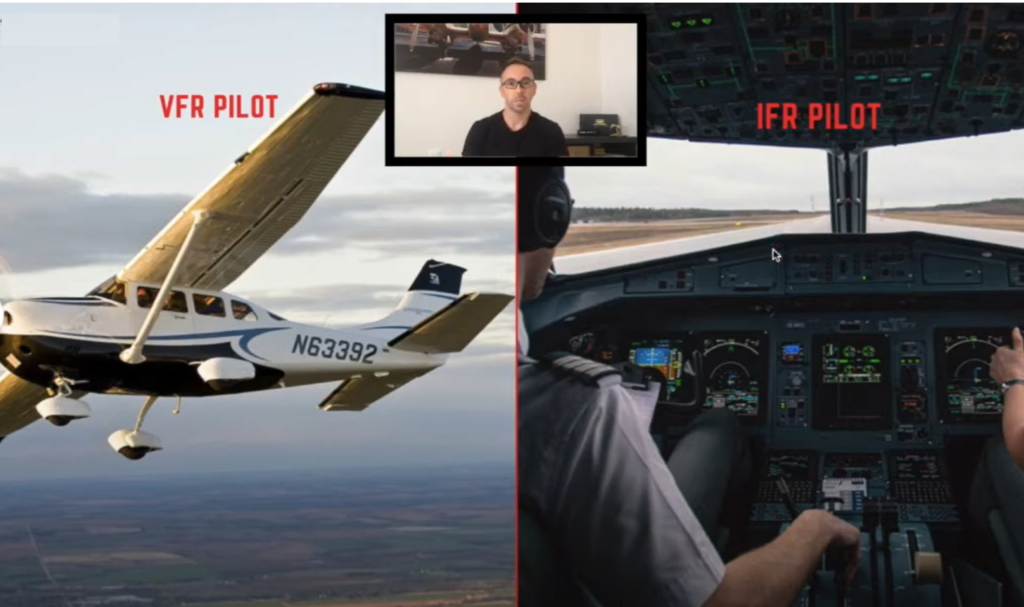Below table presents a concise differences between Visual Flight Rules (VFR) and Instrument Flight Rules (IFR), highlighting their differences in operational conditions, navigation methods, weather dependencies, equipment requirements, training needs, and operational approaches.
| Aspect | Visual Flight Rules (VFR) | Instrument Flight Rules (IFR) |
|---|---|---|
| Operational Conditions | Operates in clear weather conditions relying on visual cues. | Used in adverse weather conditions, relying on instruments. |
| Navigation | Relies on external visual references for orientation and navigation. | Navigation is primarily instrument-based, with minimal reliance on visual cues. |
| Weather Conditions | Requires clear visibility and unobstructed views. | Allows operations in adverse weather, including low visibility. |
| Equipment Requirements | Must carry necessary equipment but primarily uses visual cues. | Requires specialized navigation instruments and communication equipment. |
| Operational Approach | Straightforward, with reliance on visual references. | Demands proficiency in instrument-based navigation. |
| Weather Dependency | Dependent on clear weather conditions. | Enables safe operations in adverse weather conditions. |
| Training and Practice | Requires less training and practice. | Demands rigorous training and proficiency in instrument flying. |
| Flexibility vs. Precision | Offers flexibility in route selection. | Provides precise routing and adherence to flight plans. |

Visual Flight Rules (VFR) vs. Instrument Flight Rules (IFR): A Comparative Overview
Visual Flight Rules (VFR)
- Operational Conditions: VFR regulations govern aircraft operations in clear weather conditions, allowing pilots to navigate based on visual references.
- Visibility Requirements: Pilots must maintain visibility above specific minimum thresholds and maintain visual contact with the ground, obstacles, and other aircraft.
- Responsibilities: VFR pilots are responsible for maintaining separation from other aircraft and avoiding obstacles, relying on their own judgment and visual cues.
- ATC Interaction: While VFR flights may interact with air traffic control (ATC) for advisories and clearances, pilots are generally not assigned specific routes or altitudes by ATC.
- Equipment: VFR aircraft may not require sophisticated navigation equipment beyond standard avionics.
Instrument Flight Rules (IFR)
- Operational Conditions: IFR regulations are applicable when weather conditions deteriorate below Visual Meteorological Conditions (VMC), requiring pilots to rely on aircraft instruments for navigation.
- Navigation: Pilots operate primarily based on instrument readings, including altitude, heading, and airspeed, with minimal reliance on visual references.
- Clearance Requirement: IFR flights necessitate the filing of flight plans in advance, specifying routes and altitudes, and adherence to air traffic control (ATC) instructions throughout the flight.
- Responsibilities: ATC assumes a more active role in directing IFR flights, providing clearances, vectors, and separation services to ensure safe operations.
- Equipment: IFR aircraft must be equipped with specialized navigation and communication equipment, including altitude and heading indicators, radio navigation aids, and transponders.
Key Differences
- Weather Dependency: VFR operations are contingent upon clear weather conditions, while IFR operations enable flights to continue safely in adverse weather.
- Pilot Training: Pilots operating under IFR must undergo specific training and certification to navigate and communicate effectively in instrument meteorological conditions (IMC).
- ATC Interaction: While VFR flights may interact with ATC for advisories, IFR flights rely heavily on ATC for routing, separation, and navigation assistance.
- Flexibility: VFR flights offer greater flexibility in route selection and altitudes, whereas IFR flights follow predetermined flight plans and ATC instructions.
Conclusion
Visual Flight Rules (VFR) and Instrument Flight Rules (IFR) represent two distinct sets of regulations governing aircraft operations in different weather conditions. While VFR allows pilots to navigate visually, IFR enables safe flight in adverse weather by relying on instrument guidance and air traffic control services. Each set of rules caters to specific operational needs and weather conditions, ensuring the safety and efficiency of air traffic operations.